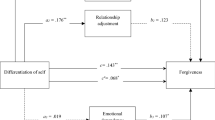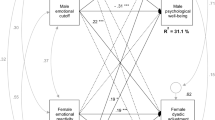Abstract
Bowen's differentiation of self construct is examined through a test in two studies of the hypothesis that people select partners at similar levels of differentiation of self. One study used a sample of married couples and the other a sample of dating and engaged couples. The studies used different instruments for determining differentiation of self. Three data analysis procedures—correlations, t-tests, and the degree of similarity procedure—provided conflicting evidence for the similarity hypothesis. Results are discussed as they pertain to statistical analysis issues using related individuals and to Bowen family systems theory and the use of this theory in clinical practice.
Similar content being viewed by others
References
Allison, M. D., & Sabatelli, R. M. (1988). Differentiation and individuation as mediators of identity and intimacy in adolescence.Journal of Adolescent Research, 3, 1–16.
Anderson, S. A., & Bagarozzi, D. A. (1983). The use of family myths as an aid to strategic therapy.Journal of Family Therapy, 5, 145–154.
Anderson, S. A., & Fleming, W. M. (1986). Late adolescents identity formation: Individuation from the family of origin.Adolescence, 21, 786–796.
Bartle, S. E. (1990).The relationships among emotional reactivity, relationship competence and relationship construction: Measurement development and validation. Unpublished doctoral dissertation, Univeristy of Connecticut.
Bartle, S. E., Anderson, S. A., & Sabatelli, R. M. (1989). A model of parenting style, adolescent individuation, and adolescent self-esteem.Journal of Adolescent Research, 4, 283–298.
Bartle, S. E., & Anderson, S. A. (1991). Similarity between parents' and adolescents' levels of individuation.Adolescence, 26, 913–924.
Bartle, S. E., & Sabatelli, R. M. (1989). Family system dynamics, identity development and adolescent alcohol use: Implications for family treatment.Family Relations, 38, 283–298.
Bowen, M. (1976). Theory and practice in psychotherapy. In P.J. Guerin (Ed.),Family therapy: Theory and practice (pp. 42–90). New York: Gardner Press.
Bowen, M. (1978).Family therapy in clinical practice. New York: Jason Aronson.
Bray, J. H., Williamson, D. S., & Malone, P. E. (1984a). Personal authority in the family system: Development of a questionnaire to measure personal authority in intergenerational family processes.Journal of Marital and Family Therapy, 10, 167–178.
Bray, J. H., Williamson, D. S., & Malone, P. E. (1984b).PAFS: Personal Authority in the Family System Questionnaire Manual. Denton, TX: Texas Woman's University.
Cebik, R. J. (1988). Adult male maturity and the attainment of personal authority in the family system.Dynamic Psychotherapy, 6, 29–36.
Fleming, W. M., & Anderson, S. A. (1986). Differentiation within the family of origin and personal adjustment in late adolescence.Journal of Marital and Family Therapy, 12(3), 311–315.
Framo, J. (1976). Family of origin as a therapeutic resource for adults in marital and family therapy: You can and should go home again.Family Process, 15, 193–210.
Friedman, E. H. (1991). Bowen theory and therapy. In A.S. Gurman & D. P. Kniskern (Eds.),Handbook of family therapy: Volume II (pp. 134–170). New York: Brunner/Mazel.
Gavazzi, S. M., & Sabatelli, R. M. (1990). Family system dynamics, the individuation process, and psychosocial development.Journal of Adolescent Research, 5, 500–519.
Gavazzi, S. M., & Sabatelli, R. M. (1987, November). Assessing levels of individuation through multigenerational connectedness. Paper presented at the annual meeting of the National Council on Family Relations, Atlanta, Georgia.
Glass, J., & Polisar, D. (1987). A method and metric for assessing similarity among dyads.Journal of Marriage and the Family, 49, 663–668.
Grotevant, H. D., & Cooper, C. R. (1986). Individuation in family relationships: A perspective on individual differences in development of identity and role taking skills in adolescence.Human Development, 29, 82–100.
Harvey, D. M., & Bray, J. H. (1991). Evaluation of an intergenerational theory of personal development: Family process determinants of psychological and health distress.Journal of Family Psychology, 4, 298–325.
Hoffman, J. A. (1984). Psychological separation of late adolescents from their parents.Journal of Counseling Psychology, 31, 170–178.
Karpel, M. (1976). Individuation: From fusion to dialogue.Family Process, 15, 65–82.
Kenny, D. A., & Acitelli, L. K. (1989). Measuring agreement and similarity in couples. Unpublished manuscript, University of Connecticut.
Kerr, M. E. (1981). Family systems theory and therapy. In A. S. Gurman & D. P. Kniskern (Eds.),Handbook of family therapy (pp. 226–264). New York: Brunner/Mazel.
Kerr, M. E. (1984). Theoretical base for differentiation of self in one's family of origin.Clinical Supervisor, 2, 3–36.
Kramer, J. R. (1985).Family interfaces: Transgenerational patterns. New York: Brun-ner/Mazel Publishers.
Lopez, F. G., Campbell, V. L., & Watkins, C. E. (1986). Depression, psychological separation, and college adjustment: An investigation of sex differences.Journal of Counseling Psychology, 33, 52–56.
Sabatelli, R. M., & Anderson, S. A. (1991). Family system dynamics, peer relationships, and adolescents' psychological adjustment.Family Relations, 40, 363–369.
Williamson, D. S. (1981). Personal authority via termination of the intergenerational hierarchical boundary: A ‘new’ stage in the family life cycle.Journal of Marital and Family Therapy, 7, 441–450.
Williamson, D. S. (1982). Personal authority in family experience via termination of the intergenerational hierarchical boundary: Part III—Personal authority defined, and the power of play in the change process.Journal of Marital and Family Therapy, 8, 309–323.
Youniss, J., & Smollar, J. (1985).Adolescent relations with mothers, fathers and friends. Chicago: University of Chicago Press.
Author information
Authors and Affiliations
Rights and permissions
About this article
Cite this article
Bartle, S.E. The degree of similarity of differentiation of self between partners in married and dating couples: Preliminary evidence. Contemp Fam Ther 15, 467–484 (1993). https://doi.org/10.1007/BF00892293
Issue Date:
DOI: https://doi.org/10.1007/BF00892293




